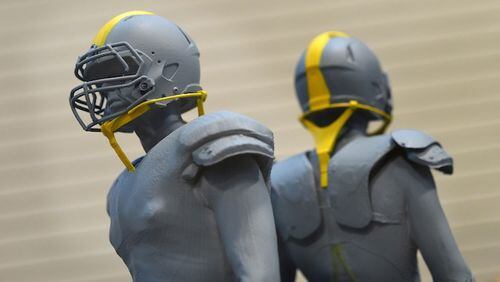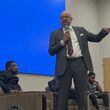The NFL’s quest to become safer has extended to a U.S. Army lab, where rubbery, fluid-filled straps tether a crash test dummy's football helmet to its body. While they allow turning of the head, the straps tighten automatically under jarring blows to minimize violent head whips.
Designed by Army Research Laboratory scientists at Aberdeen Proving Ground in Aberdeen, Md., the "smart" strap system was one of three recent winners of an open competition for funding to develop new approaches to deter players' brain injuries during a critical period for the NFL.
Concussions are a billion-dollar problem for the league that's about to get massive star turn that will cast even more light on the issue and raise more questions about how it's trying to tackle a problem that could threaten the sport's future.
A federal judge in April approved a potential $1 billion deal to settle thousands of concussion cases brought against the NFL by former players, but some retired players are challenging the settlement because it doesn't recognize a diagnosis of chronic traumatic encephalopathy, or CTE, while players are living.
A forensic pathologist's battle with the league to acknowledge CTE, a degenerative disease found in many players after their deaths, is the subject of a new film, called "Concussion," to be released Christmas Day that spotlights head injuries and stars Will Smith.
Criticized for not addressing the problem for years, the NFL is working now to get ahead of it, changing rules to minimize the injuries and funding research into new technologies through the competition sponsored by Under Armour and General Electric.
"If the conversation on the health and safety of our sport is in the public consciousness, whether it be as the result of this movie or just a general discussion about the NFL, then we're happy to engage in that conversation," said Jeff Miller, senior vice president of health and safety for the NFL.
But the league faces a difficult balancing act to protect players _ particularly its stars _ without tampering too much with the game, said Bob Dorfman, executive creative director of Baker Street Advertising in San Francisco.
"The violence of the game is what people like," Dorfman said. "They like the big hits."
The soldier-protection experts at the Aberdeen lab took up the challenge after the NFL announced the competition in 2013. The research may have applications for the military, particularly paratroopers, who suffer concussions at a higher rate than other soldiers.
The Army lab initially received $500,000 in 2014 and now will get up to $1 million more from the NFL, Under Armour and GE. The three plan to collectively spend up to $20 million to fund the ideas.
"We don't make helmets. There may be no commercial opportunity for us in this at the end," said Sam McCleery, a vice president at Under Armour, the Baltimore-based athletic apparel company. "But it's something that's important. Under Armour's brand was born on the field. With (CEO) Kevin (Plank) as a player, we have a heritage with the game."
Through its participation, Under Armour hopes to make safety "cool," McCleery said.
"We're going to try to bring some coolness factor so we get early adoption and better engagement as we roll this thing out," he said.
The straps the Army lab developed are stretchy tubes containing an engineered liquid that changes consistency when stress is applied.
"If you pull it slowly, it stretches and relaxes slowly," said Eric Wetzel, one of the lab's research scientists. "If you try to pull it quickly, it takes 100 times more force."
It's the same principle as car seat belts that are normally slack but tighten in a crash.
Connected to a narrow, C-shaped rail underneath the face mask, the tubes attach to the body underneath the uniform, at the pelvis.
On a recent afternoon, the lab tested the tubes on a crash test dummy wearing a white football helmet. The torso was mounted on a pivot arm that repeatedly allowed the head to free-fall backward onto the floor.
The tubes are designed to allow voluntary motion but to stabilize the head during backwards falls like the one sustained by St. Louis Rams quarterback Case Keenum in a Nov. 22 game against the Ravens, Wetzel said. Keenum remained on his hands and knees after a hit by the Ravens' Timmy Jernigan. He stayed in the game but was later diagnosed with a concussion.
The Rams weren't punished for their coaches' handling of Keenum, although the NFL said afterward that "medical experts from the league and the Players Association will continue to review the protocols and make improvements as necessary."
Wetzel said he also was watching last Sunday when the back of Ravens quarterback Matt Schaub's head struck the turf in the 15-13 loss to the Miami Dolphins. Schaub quickly grabbed the back of his helmet and was slow to come off the field, but he did not miss a play and was not diagnosed with a concussion.
The NFL said the Ravens took the correct precautions with Schaub, who went through a standard concussion protocol during the game. "The protocol was followed to a 'T,' " Ravens coach John Harbaugh said.
But others say the league still isn't doing enough.
"In the past few weeks, the NFL's concussion protocol has failed miserably to protect its players," T.J. Brightman, president of A. Bright Idea, a communications and advertising agency in Bel Air, Md. "The NFL needs to be very careful how they not only handle increased scrutiny now -- with the release of the film -- but also must establish some clearer guidelines and procedures moving forward."
Wetzel, an expert in materials and mechanics who is also a football fan, said of Schaub: "All would agree that we would rather he not have to take hard head-to-ground hits like this. Our technology slows the head during the swing so that when the head-to-ground impact occurs, it is with less force and velocity."
The goal is to develop a device that a private company could commercialize, initially targeting youth football because "it will have the bigger impact," Wetzel said. "We don't commercialize anything, so we need commercial buy-in."
The other winners -- who are also eligible for up to a million dollars in funding -- include Viconic Sporting, a Michigan company that developed an underlayer for synthetic turf systems; and the University of Washington, which is developing a helmet to better absorb impact.
"Over the short term, the sponsors are going to continue to work with them," Miller said of the winners. "And then they would compete in the marketplace. The NFL is not licensing any technologies here, we're not owning any company."
Even with advances, professional football will remain "inherently unsafe," said neurologist Dr. Alan Faden, a University of Maryland medical school professor.
"The question is, can one do things to reduce the risk?" Faden asked. "I think, yes."
Like the Army lab in its winning design, Faden said he has worked with elastomers -- synthetic materials that can act as shock absorbers.
"An elastomer concept is exactly the kind of thing I think is needed" in football, he said. "The existing materials have not really dealt with the problem of rotational acceleration."
Another neurologist, New York-based Barry Jordan, said the NFL has "made a big difference" in recent years by barring helmet-to-helmet collisions, limiting full contact during practices and moving the kickoff spot forward to curb the number of returns.
Jordan, a member of the National Football League Players Association's health and safety committee, wasn't familiar with the specifics of the Army lab project, but said any researchers face a serious challenge trying to mitigate concussions with new equipment.
"It's going to be difficult simply because the mechanism of concussions is movement of the head," he said. "It's almost impossible to prevent movement of the head."






